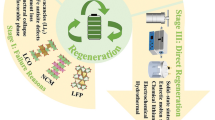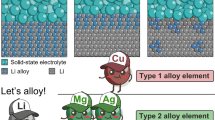Abstract
The study elementarily investigated the effect of the cathode structure on the electrochemical performance of anode-supported solid oxide fuel cells. Four single cells were fabricated with different cathode structures, and the total cathode thickness was 15, 55, 85, and 85 µm for cell-A, cell-B, cell-C, and cell-D, respectively. The cell-A, cell-B, and cell-D included only one cathode layer, which was fabricated by \( \left( {{\text{La}}_{0.74} {\text{Bi}}_{0.10} {\text{Sr}}_{0.16} } \right){\text{MnO}}_{{3 - \delta }} \) (LBSM) electrode material. The cathode of the cell-C was composed of a \( \left( {{\text{La}}_{0.74} {\text{Bi}}_{0.10} {\text{Sr}}_{0.16} } \right){\text{MnO}}_{{3 - \delta }} - \left( {{\text{Bi}}_{0.7} {\text{Er}}_{0.3} {\text{O}}_{1.5} } \right) \) (LBSM–ESB) cathode functional layer and a LBSM cathode layer. Different cathode structures leaded to dissimilar polarization character for the four cells. At 750°C, the total polarization resistance (R p) of the cell-A was 1.11, 0.41 and 0.53 Ω cm2 at the current of 0, 400, and 800 mA, respectively, and that of the cell-B was 1.10, 0.39, and 0.23 Ω cm2 at the current of 0, 400, and 800 mA, respectively. For cell-C and cell-D, their polarization character was similar to that of the cell-B and R p also decreased with the increase of the current. The maximum power density was 0.81, 1.01, 0.79, and 0.43 W cm−2 at 750°C for cell-D, cell-C, cell-B, and cell-A, respectively. The results demonstrated that cathode structures evidently influenced the electrochemical performance of anode-supported solid oxide fuel cells.



Similar content being viewed by others
References
Ujiie T (2007) ECS Trans 7:3. doi:10.1149/1.2729066
Surdoval WA (2007) ECS Trans 7:11. doi:10.1149/1.2729067
Rietveld B (2007) ECS Trans 7:17. doi:10.1149/1.2729068
Mai A, Haanappel VAC, Uhlenbruck S, Tietz F, Stover D (2005) Solid State Ion 176:1341. doi:10.1016/j.ssi.2005.03.009
Tietz F, Haanappel VAC, Mai A, Mertens J, Stover D (2006) J Power Sources 156:20. doi:10.1016/j.jpowsour.2005.08.015
Murray EP, Sever MJ, Barnett SA (2002) Solid State Ion 148:27. doi:10.1016/S0167-2738(02)00102-9
Tu HY, Takeda Y, Imanishi N, Yamamoto O (1999) Solid State Ion 117:277. doi:10.1016/S0167-2738(98)00428-7
Yamamoto O, Takeda Y, Kanno R, Noda M (1987) Solid State Ion 22:241. doi:10.1016/0167-2738(87)90039-7
Jiang SP, Wang W (2005) Solid State Ion 176:1351. doi:10.1016/j.ssi.2005.03.011
Tsai T, Barnett SA (1997) Solid State Ion 98:191. doi:10.1016/S0167-2738(97)00113-6
Erning JW, Hauber T, Stimming U, Wipperman K (1996) J Power Sources 61:205. doi:10.1016/S0378-7753(96)02358-0
Wang S, Kato T, Nagata S, Kaneko T, Iwashita N, Honda T, Dokiya M (2002) Solid State Ion 152:477. doi:10.1016/S0167-2738(02)00376-4
Sahibzada M, Benson SJ, Rudkin RA, Kilner JA (1998) Solid State Ion 113:285. doi:10.1016/S0167-2738(98)00294-X
Wang S, Kato T, Nagata S, Honda T, Kaneko T, Iwashita N, Dokiya M (2002) Solid State Ion 146:203. doi:10.1016/S0167-2738(01)01015-3
Sasaki K, Tamura J, Dokiya M (2001) Solid State Ion 144:233. doi:10.1016/S0167-2738(01)00972-9
Watanabe M, Uchida H, Shibata M, Mochizuki N, Amikura K (1994) J Electrochem Soc 141:342. doi:10.1149/1.2054728
Uchida H, Yoshida M, Watanabe M (1999) J Electrochem Soc 146:1. doi:10.1149/1.1391555
Sasaki K, Tamura J, Hosoda H, Lan TN, Yasumoto K, Dokiya M (2002) Solid State Ion 148:551. doi:10.1016/S0167-2738(02)00116-9
Tsai T, Barnett SA (1997) Solid State Ion 93:207. doi:10.1016/S0167-2738(96)00524-3
Jørgensen MJ, Primdahl S, Mogensen M (1999) Electrochim Acta 44:4195. doi:10.1016/S0013-4686(99)00134-6
Juhl M, Primdahl S, Manon C, Mogensen M (1996) J Power Sources 61:173. doi:10.1016/S0378-7753(96)02361-0
Hart NT, Brandon NP, Day MJ, Lapena-Rey N (2002) J Power Sources 106:42. doi:10.1016/S0378-7753(01)01035-7
Lee YK, Kim JY, Lee YK, Kim I, Moon HS, Park JW, Jacobson CP, Visco SJ (2003) J Power Sources 115:219. doi:10.1016/S0378-7753(02)00727-9
Sasaki K, Wurth JP, Gschwen R, Godickemeier K, Gauckler LJ (1996) J Electrochem Soc 143:530. doi:10.1149/1.1836476
Haanappel VAC, Mertens J, Rutenbeck D, Tropartz C, Herzhof W, Sebold D, Tietz F (2005) J Power Sources 141:216. doi:10.1016/j.jpowsour.2004.09.016
Wang ZR, Qian JQ, Cao JD, Wang SR, Wen TL (2007) J Alloy Comp 437:264. doi:10.1016/j.jallcom.2006.07.110
Li JL, Wang SR, Wang ZR, Liu RZ, Wen TL, Wen ZY (2008) J Power Sources 179:474. doi:10.1016/j.jpowsour.2008.01.017
Van Heuveln FH, Bouwmeester HJM (1997) J Electrochem Soc 144:134. doi:10.1149/1.1837375
Acknowledgment
This work is supported financially by the Chinese High Technology Development Project (2007AA05Z151).
Author information
Authors and Affiliations
Corresponding author
Rights and permissions
About this article
Cite this article
Li, J., wang, S., Wang, Z. et al. Effect of the cathode structure on the electrochemical performance of anode-supported solid oxide fuel cells. J Solid State Electrochem 14, 579–583 (2010). https://doi.org/10.1007/s10008-009-0813-6
Received:
Revised:
Accepted:
Published:
Issue Date:
DOI: https://doi.org/10.1007/s10008-009-0813-6




